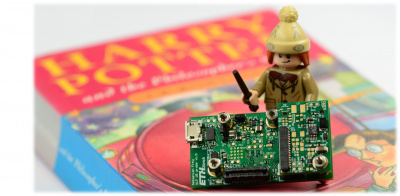Difference between revisions of "Design of combined Ultrasound and PPG systems"
From iis-projects
(Created page with "thumb|right|400px == Short Description == Ultrasound (US) imaging is a non-invasive imaging technique that provides visible information on the structure...") |
|||
| (9 intermediate revisions by 2 users not shown) | |||
| Line 1: | Line 1: | ||
[[File:ULPdot.jpg |thumb|right|400px]] | [[File:ULPdot.jpg |thumb|right|400px]] | ||
| − | + | ||
== Short Description == | == Short Description == | ||
Ultrasound (US) imaging is a non-invasive imaging technique that provides visible information on the structure of musculoskeletal tissues, organs, and vascular system. Recent research trends include the development of wearable US probes, with minimal power consumption and reduced count of piezoelectric elements. In fact, meaningful physiological information can be derived also from single-element transducers. | Ultrasound (US) imaging is a non-invasive imaging technique that provides visible information on the structure of musculoskeletal tissues, organs, and vascular system. Recent research trends include the development of wearable US probes, with minimal power consumption and reduced count of piezoelectric elements. In fact, meaningful physiological information can be derived also from single-element transducers. | ||
| Line 6: | Line 6: | ||
In the context of the monitoring of biological signals (such as heart rate), Photoplethysmography (PPG) is a very common technique to detect blood volume changes, and even blood pressure. | In the context of the monitoring of biological signals (such as heart rate), Photoplethysmography (PPG) is a very common technique to detect blood volume changes, and even blood pressure. | ||
| − | The scope of this project is to design an acquisition platform capable of collecting together and in a synchronized way US and PPG data. The ultra-low-power US probe of [1] will be considered as starting design point, and an integrated prototype adding a PPG sensor (e.g. | + | The scope of this project is to design an acquisition platform capable of collecting together and in a synchronized way US and PPG data. The ultra-low-power US probe of [1] will be considered as starting design point, and an integrated prototype adding a PPG sensor (e.g. MAX86141) will be designed. |
=== Goal & Tasks === | === Goal & Tasks === | ||
In this project, you will work on the extension of a novel wearable US probe [1] to capture also PPG signals. The main tasks are: | In this project, you will work on the extension of a novel wearable US probe [1] to capture also PPG signals. The main tasks are: | ||
| − | * Programming the NRF52 evaluation board to collect in a parallel and synchronized way US data (from an MSP430 MCU) and PPG data (collected with a | + | * Programming the NRF52 evaluation board to collect in a parallel and synchronized way US data (from an MSP430 MCU) and PPG data (collected with a MAX86141 or similar products) |
* PCB design of an integrated probe | * PCB design of an integrated probe | ||
* proof of concept experiments | * proof of concept experiments | ||
| Line 18: | Line 18: | ||
===Literature=== | ===Literature=== | ||
* [https://iis-projects.ee.ethz.ch/index.php?title=Ultra_low_power_wearable_ultrasound_probe] Ultra low power wearable ultrasound probe | * [https://iis-projects.ee.ethz.ch/index.php?title=Ultra_low_power_wearable_ultrasound_probe] Ultra low power wearable ultrasound probe | ||
| − | |||
| − | |||
=== Prerequisites === | === Prerequisites === | ||
| Line 55: | Line 53: | ||
[[Category:LightProbe]] | [[Category:LightProbe]] | ||
[[Category:Ultrasound]] | [[Category:Ultrasound]] | ||
| + | [[Category:USfw]] | ||
| + | [[Category:UShw]] | ||
[[Category:UltrasoundDot]] | [[Category:UltrasoundDot]] | ||
| + | [[Category:UScharacterization]] | ||
| + | [[Category:SmartSensors]] | ||
| + | [[Category:EmbeddedAI]] | ||
| + | [[Category:WearablesHealth]] | ||
Latest revision as of 19:02, 6 December 2023
Contents
Short Description
Ultrasound (US) imaging is a non-invasive imaging technique that provides visible information on the structure of musculoskeletal tissues, organs, and vascular system. Recent research trends include the development of wearable US probes, with minimal power consumption and reduced count of piezoelectric elements. In fact, meaningful physiological information can be derived also from single-element transducers. Within this framework, at IIS we have recently developed an ultra-low power wearable US probe, based on an MSP430 and nRF52 microcontrollers, operating with a single US channel and consuming less than 20mW [1].
In the context of the monitoring of biological signals (such as heart rate), Photoplethysmography (PPG) is a very common technique to detect blood volume changes, and even blood pressure. The scope of this project is to design an acquisition platform capable of collecting together and in a synchronized way US and PPG data. The ultra-low-power US probe of [1] will be considered as starting design point, and an integrated prototype adding a PPG sensor (e.g. MAX86141) will be designed.
Goal & Tasks
In this project, you will work on the extension of a novel wearable US probe [1] to capture also PPG signals. The main tasks are:
- Programming the NRF52 evaluation board to collect in a parallel and synchronized way US data (from an MSP430 MCU) and PPG data (collected with a MAX86141 or similar products)
- PCB design of an integrated probe
- proof of concept experiments
Literature
- [1] Ultra low power wearable ultrasound probe
Prerequisites
- embedded C
- Python
- Microcontrollers
- PCB design
Status: Available
- Supervision: Sergei Vostrikov, Andrea Cossettini
Character
- 10% Literature Study
- 25% PCB design
- 65% Microcontroller programming
